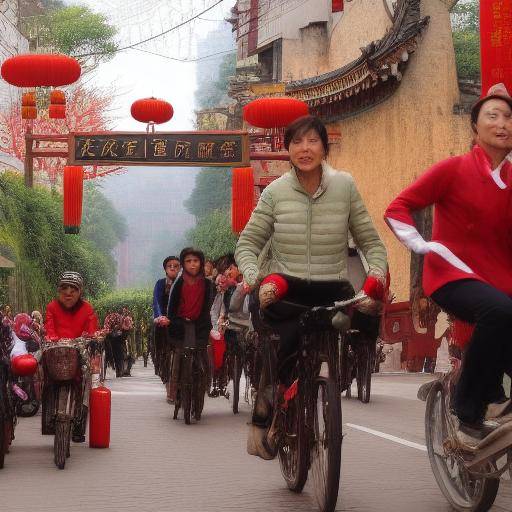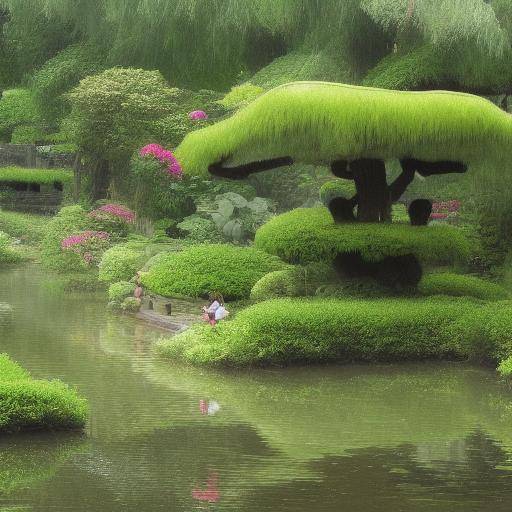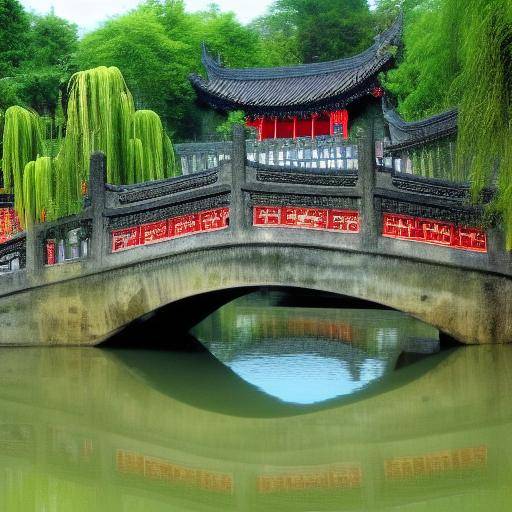
Tea has been an integral part of Chinese culture for centuries, being much more than just a drink. In this article, we will explore the fascinating history of tea in China, its influence on the tea ceremony and how this tradition has endured over generations. From the historical origins of Chinese tea to contemporary practices, we will discover how tea has shaped the cultural identity of China. In addition, we will analyze current trends, compare Chinese tea with other varieties and ceremonies, and see how the future of tea in China is glimpsed. Get ready to immerse yourself in the exciting world of Chinese tea and discover its entrenched tradition and culture!
Introduction
The tea ceremony in China is much more than a simple tradition. It represents a life-form rooted in human history, philosophy and relationships. Since ancient times, tea has played a fundamental role in the daily life of the Chinese, influencing the way they relate to each other and to nature. Exploring the tea route in China is to enter a universe of ancestral customs, spiritual refinement and respect for nature. Throughout this journey, we will discover the legacy of tea in Chinese culture and how it has survived over the centuries, keeping its relevance despite the evolution of the modern world.
History and History of Tea in China
Tea has its roots in ancient China, where it has archaeological evidence that demonstrates its cultivation and consumption for more than 4000 years. According to legend, Emperor Shen Nong accidentally discovered tea at 2737 BC when some leaves fell into a boiling water pot, creating a fragrant infusion. Since then, tea has become a pillar of Chinese culture, playing a crucial role in medicine, religion, diplomacy and domestic life.
During the Tang dynasty (618-907 AD), tea experienced an unprecedented boom, becoming a popular drink throughout Chinese society. The Song dynasty (960-1279 AD) marked the emergence of quality ceramics to drink tea, leading to the appearance of the first specialized teapots and cups. The Ming dynasty (1368-1644 AD) consolidated the aesthetics and ritualization of tea, leading to the creation of the tea ceremony as a tool to promote spirituality and harmony.
The arrival of the Qing dynasty (1644-1912 AD) saw the diversification of Chinese tea and its trade worldwide. Tea became a currency of vital exchange in trade relations with the West, which triggered a global demand for this precious infusion. Today, tea remains a symbol of Chinese cultural heritage, with countless varieties and practices that reflect its rich history and tradition.
Deep Chinese Tea Analysis
Chinese tea encompasses a wide range of varieties, each with its taste, aroma and distinctive properties. From the delicate and floral white tea to the robust and stubborn pu-erh tea, the diversity of Chinese tea is a reflection of the different regions, climates and cultivation techniques of China. In addition to its exquisite flavor, Chinese tea offers a multitude of health benefits, from antioxidant properties to relaxing and stimulating effects. Chinese tea is not only a drink, but a lifestyle that fosters physical and emotional well-being.
However, despite its popularity and entrenched tradition, Chinese tea faces challenges in the modern era. Rapid industrial development and globalization have raised concerns about the sustainability and quality of Chinese tea, as well as competition with other modern drinks. While tea remains a pillar of Chinese culture, it has adapted to the changing demands of the market, leading to packaging innovations and the emergence of new trends, such as iced tea and flavored tea drinks.
Today, Chinese tea continues to captivate consumers around the world, with a prosperous export sector that promotes diversity and quality. As awareness of health and well-being continues to grow, Chinese tea is presented as an attractive and natural choice for beverage lovers, both inside and outside China. Its multiple varieties offer an incomparable sensory experience, which goes beyond satisfying thirst, becoming a form of connection with nature and appreciation of traditional Chinese crafts.
Exhaustive Review of Tea Ceremony in China
The tea ceremony in China is a practice rooted in Confucian and Taoist philosophy, which promotes harmony, reflection and respect for nature. More than just tea preparation and consumption, the tea ceremony is an artistic expression, a social interaction and a spiritual experience. Each gesture, from warming the water to pouring the infusion, is imbued with meaning and reverence, creating a moment of human connection and contemplation. The tea ceremony embodies the fundamental values of Chinese culture, such as courtesy, equilibrium and gratitude, and is considered a way of realizing time and space.
Described often as a quiet dance, the tea ceremony is based on full attention and respect for others and oneself. Through the conscious preparation and consumption of tea, participants seek to achieve a state of calm and presence, enjoying the present moment in complete harmony. The tea ceremony also serves as a means to connect with nature, honoring its influence in the process of growing and producing tea. Each detail, from the type of teapot to the water temperature, is carefully selected to enhance the essence of tea and create a unique and enriching sensory experience.
In the contemporary era, the tea ceremony in China has experienced revitalization, extending beyond traditional circles and adapting to modern tastes and lifestyles. From elegant tea rooms in the cities to rural retreats that offer personalized tea experiences, the tea ceremony continues to captivate enthusiasts of all ages and backgrounds. As more people discover the beauty and depth of this ancient practice, the tea ceremony in China continues to flourish, incarnating the country's rich cultural heritage and resonating in the hearts of those who embrace it.
Comparative Analysis between Chinese Tea, China and Tea Ceremony
Chinese tea is an intrinsic reflection of Chinese culture, with its many varieties and practices that celebrate diversity, crafts and the connection with nature. Chinese culture, in turn, has shaped the way tea is cultivated, prepared and consumed, infusing every step with meaning, symbolism and respect for ancestral traditions. The tea ceremony, as an artistic and spiritual expression, is the point of convergence where Chinese tea and culture intertwine, creating a space for contemplation, dialogue and the celebration of life.
Although tea is an integral part of Chinese culture, its influence extends far beyond its borders, transcending linguistic and cultural barriers to becoming a global symbol of hospitality, friendship and well-being. The tea ceremony has also found its place in various cultural contexts, adapting to local sensitivities and enriching the tea experience with new perspectives and approaches. Through this intercultural dialogue, Chinese tea and tea ceremony have become bridges for mutual understanding, knowledge-sharing and the promotion of respect for cultural diversity.
While Chinese tea represents the diversity and wealth of Chinese cultural heritage, the tea ceremony embodies the fundamental values of Chinese society, such as respect, hospitality and harmony with nature. Through this shared appreciation, a space for intercultural dialogue is created, allowing Chinese tea and tea ceremony to transcend borders and connect people of different origins in a spirit of camaraderie and mutual understanding.
Practical Tips and Accessible Tips
If you are interested in discovering the world of Chinese tea and tea ceremony, here are some practical tips that will help you fully appreciate and enjoy this fascinating tradition:
- Explore the different varieties: Dedicate time to discover the diversity of Chinese tea, from oolong to pu-erh, and experiment with its different flavor profiles and unique aromas.
- Research on the tea ceremony: Dive into the foundations of the tea ceremony, from its origins to its contemporary practices, and understand its spiritual and cultural significance.
- Enjoy the moment: When preparing and tasting the tea, focus on every detail, from the aroma that emanates from the leaves to the color and taste of the infusion, and allows the tea to take you to a state of calm and contemplation.
- Share the experience: Invite friends and family to participate in a tea ceremony, sharing this special moment with those you value, and fostering human connection through a cup of tea.
Conclusion
In short, the tea route in China brings us through an exciting history of tradition, culture and human connection. From its humble beginnings to its global influence, Chinese tea and tea ceremony represent the very essence of Chinese philosophy and life. Through the exploration of its historical roots, current benefits and emerging trends, we can appreciate the immense cultural wealth that Chinese tea brings to the world.
Looking forward, it is clear that Chinese tea and tea ceremony will remain a beacon of Chinese identity and heritage, serving as symbols of hospitality, friendship and well-being in an increasingly interconnected world. This lasting legacy invites us to appreciate the beauty of Chinese tea and immerse ourselves in an experience that goes beyond a simple drink, getting into a universe of meaning, tradition and harmony.
FAQs
1. What is the most famous tea in China?
China's most famous tea is Longjing's green tea, also known as "White Dragon". This tea is grown in the region of Hangzhou and is characterized by its flat leaves and fresh and sweet flavor.
2. What is the cultural significance of the tea ceremony in China?
The tea ceremony in China is a practice that reflects the values of harmony, respect and gratitude. It is an expression of courtesy, refinement and connection to nature, which has shaped the social and spiritual interactions of Chinese culture for centuries.
3. What are the health benefits of Chinese tea?
Chinese tea offers a wide range of health benefits, including antioxidant properties, relaxing and stimulating effects, as well as promotion of cardiovascular health, digestion and mental concentration.
4. How is Chinese tea traditionally prepared and consumed?
The traditional preparation and consumption of Chinese tea involve the use of hot water at the right temperature, serving tea in special cups and enjoying it in a quiet and contemplative atmosphere, in the company of friends, family or in a tea ceremony.
5. How has the tea ceremony evolved in modern China?
The tea ceremony in modern China has experienced an adaptation to contemporary lifestyles, with new approaches that incorporate full attention, aesthetics and diversity of practices, allowing more people to connect with this ancient tradition in a meaningful way.
6. What are the current trends in Chinese tea production and consumption?
Current trends in Chinese tea production and consumption include an approach to sustainability, packaging innovation, variety diversification and increased demand in the international market, as well as the growth of tea culture in modern China.
Throughout this tour of the tea route in China, we have discovered the rich history, cultural influence and the global significance of Chinese tea and tea ceremony. From their humble origins to their role as a symbol of hospitality and well-being, Chinese tea and tea ceremony invite us to appreciate the beauty, depth and harmony that this ancient tradition brings to our lives. May this knowledge inspire you to immerse yourself in the exciting world of Chinese tea and find meaning, tranquility and connection in every sip of this precious infusion. Enjoy the flavor, culture and history that Chinese tea has to offer, and let yourself be carried away by the magic of the tea ceremony in China.
External Links:
- China Highlights - Introducing Chinese Tea
- Tea Journey Magazine - Exploring the World of Tea
- The Art of Tea - Understanding Chinese Tea Culture
This article explores all aspects of Chinese tea, Chinese culture and tea ceremony, from its history to its practical applications and its contemporary relevance. I hope you find the information provided useful, informative and entertaining. If you have any additional questions or would like to explore further the fascinating world of Chinese tea, do not hesitate to find more resources or contact experts on the subject. May your journey through the tea route in China be enriching and satisfying!



